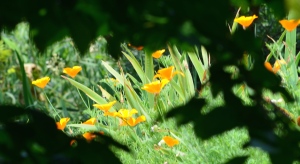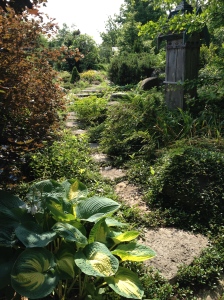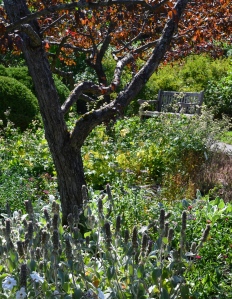 “We need plants to be more than just the parsley to the pot roast of our house”, he said. Ok. I’m in.
“We need plants to be more than just the parsley to the pot roast of our house”, he said. Ok. I’m in.
Thomas Rainer, landscape architect and co-author with Claudia West of Planting In A Post-Wild World: Designing Plant Communities For Resilient Landscapes, has a way with plants and words. His landscape designs look like blurred tapestries of blended colour, texture and movement. And when he spoke recently at the Royal Botanical Gardens near Hamilton, Ontario, he had everyone, including me, leaning into what can best be described as a new gardening mindset. He called it “ecologically expressive design”. I wasn’t exactly sure what that meant at first but by the end of his speech, he had me and the entire packed audience ready to sign up.
 So how do you express ecology?
So how do you express ecology?
Clearly ecologically expressive anything would have to involve wild things and in the case of Rainer’s approach to landscape architecture it most certainly includes the use of native plants. But Rainer asked us “Why are suburban gardens not filled with native plantings?” He argued that part of the reason is a lack of understanding. I’d have to agree. Even I’m put off by the half-hearted displays of native plants at my local garden centres. Usually stuck to one side, looking lanky, feeble or parched. Rainer asked “Can we make gardens with native plants appeal to the lawn owner worried about curb appeal?”
His short answer was yes. “Keep your aliens!” he said. But remember that “perennials don’t have to be high maintenance divas.” Then, start adding natives. By doing so, you can make a sustainable garden that’s aesthetically pleasing. And, long term, the benefits for the gardener include moving from a maintenance role to one of management.
Rainer added that part of this process should include a change in the way we see beauty in the garden. A simple exercise in making this change is considering new colour palettes. Rather than creating a flower bed vibrating with two theme colours such as chartreuse and burgundy, for instance, try choosing a multi-tonal combination inspired by what you see in the wild. Once you start looking in this direction, it’s hard not to see the many, many colours around us. Colours of the soil–brown, or terracotta, or buff. Rocks–I can think of white, silver, rose, slate. The bark of trees–the creamy white of birch bark, the metallic burgundy of a birch bark cherry. This list can go on and on.
 On the way to green hedonism
On the way to green hedonism
Rainer wants to get a new message across, the key words being “green hedonism”. “We should choose plants that give pleasure and create our gardens to give us pleasure.” All plants. Aliens. Natives. But, most importantly, aliens and natives. In lush profusion. If you can look at all plants this way, Rainer assured us, you’re looking at the future of native plant gardens.
The problem is that in our gardens, we tend to arrange plants as individuals. “In the wild,” Rainer points out, “plants are social. They grow in communities. We change our sites to eliminate stress for the new plants we’re adding, like amending the soil. But in the wild, plants have adapted to the stresses of a place.” They are all in a complex and adaptive community. In an ironic twist, you get a bonus to this kind of planting. “Soil fertility is your enemy!” he said, pointing out that lots of native plants are used to growing in less fertile soil.
It’s all in the layers
Rainer then broke down for us how to design plant communities. By the way, Rainer insisted this style can be done in smaller, suburban-sized gardens, too, showing us gorgeous photos of gardens to prove it. (His book has some good examples, as well.) There are three basic layers:
- THE STRUCTURAL LAYER: From 5% to 15% of the composition is made up of this layer–trees, shrubs, and tall perennials such as milkweed.
- THE MID-HEIGHT LAYER: This is the seasonal theme layer, making up 30% to 40% of the overall composition. “This is where the colour comes in.” he said. “Here are the divas, the textural specimens.”
- THE GROUND COVER LAYER: Up to 50% of your plant material is made up of these plants which take the place of mulch–Carex, Sedges, Heuchera longiflora, Juncus tenuis.
 The first and second layer are the design layers where, as he describes it, you imbue your design with “legibililty”. The third layer is the functional layer, also bringing diversity. (In his book, he includes a small (5%-10%) fourth layer of filler plants, short-lived species used to temporarily fill in gaps for short seasonal display which also serve as part of the functional layer.)
The first and second layer are the design layers where, as he describes it, you imbue your design with “legibililty”. The third layer is the functional layer, also bringing diversity. (In his book, he includes a small (5%-10%) fourth layer of filler plants, short-lived species used to temporarily fill in gaps for short seasonal display which also serve as part of the functional layer.)
“If you do one thing,” urged Rainer, “replace your mulch with plants.” You’ll get a prettier garden and you’re essentially imitating nature”–with all the benefits of plant synergies that comes with that. “We use mulch as a ground cover but it keeps our plants in a perpetual phase of establishing,” he said. In the wild, plants must quickly establish themselves and they use other plants as green mulch.
But what about your next-door neighbours who won’t understand that you’re embracing this revolutionary “ecologically expressive design” as Rainer so winningly puts it? What if they’re bound to think you’ve just let your lawn go to pot? Rainer points out that “you can make this kind of planting look more intentional by using frames” such as rock borders, even clipped hedges. By keeping some of the vernacular of traditional gardening, you communicate that this new garden is not only beautiful, it’s supposed to be this way.
 The once and future garden
The once and future garden
Rainer is convinced “the Renaissance of horticulture will happen in cities” starting with gardeners who may do something their neighbours might not like initially. But we have to try. “We have the opportunity to create gardens that remind us of the wild,” he said. It’s not lost on horticultural futurists like himself that one of the biggest attractions in New York City at the moment is the Highline–what he calls “a memorial to a meadow.”
“We can take the best of both worlds–wild and horticultural–and make a designed plant community. This is relevant now than ever before. [The garden] has to be beautiful and sustainable–the intersection of horticulture and ecology–allowing plant dynamics within an aesthetic framework,” Rainer said to wrap up his speech.
There was a pause as this last message sunk in. And then there was a loud burst of applause.
About the book
For a well-written review of Rainer and West’s book, I recommend you jump over to fellow blogger Jean Potuchek’s post entitled “Favourite Garden Books: Planting In A Post-Wild World“. She’s done an excellent job of explaining what to find in the book and what it means to gardeners. I believe that after reading her posting, you won’t be able to resist ordering the book. And come spring, we’ll be planting that ground cover–Green Hedonists, all.




Pingback: Ministry of the fence New, old foodscaping ideas for any garden
I have always been a green hedonist! My lack of space is already making me use plants for mulch, I view the makeup of a healthy garden as the FDA views the food pyramid (with natives being the base layer). That said, I still struggle with my appetite for junk food. 😉 This post – and probably, book – was right up my alley! 🙂
LikeLike
LOL! Love your food pyramid analogy. Yes, more natives are good for you. And Mr. Rainer tells you how to get more into your garden in gorgeous ways.
LikeLiked by 1 person
Crys, Thanks for the shout-out. I love the quote from Rainer’s talk that you opened with. I also appreciate the way that the perspective on his ideas you provide here enriches what I got from reading the book.
LikeLiked by 1 person